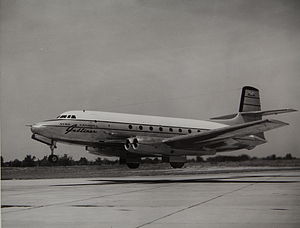Avro Jetliner
| C102 Jetliner | |
|---|---|
 |
|
| Role | Jet airliner |
| National origin | Canada |
| Manufacturer | Avro Canada |
| First flight | 10 August 1949 |
| Primary user | Trans Canada Airlines (intended) |
| Number built | One (second prototype cancelled while in production, and scrapped) |
The Avro C102 Jetliner was a Canadian prototype medium-range turbojet-powered jet airliner built by Avro Canada in 1949. It was beaten to the air by only 13 days by the de Havilland Comet, thereby becoming the second jet airliner in the world. The name "Jetliner" was chosen as a shortening of the term "jet airliner", a term which is still in popular usage in Canada and the United States. The aircraft was considered suitable for busy routes along the US eastern seaboard and garnered intense interest, notably from Howard Hughes who even offered to start production under license. However continued delays in Avro's all-weather interceptor project, the Avro CF-100, led to an order to stop working on the project in 1951, with the prototype Jetliner later cut up for scrap.
In 1945 Trans-Canada Airlines (TCA) started exploring a number of aircraft developments under the direction of Jim Bain. Avro of England, who had recently taken over the Victory Aircraft "shadow factory" in Toronto, and started exploring production possibilities with TCA for a twin-engine turboprop aircraft like the Vickers Viscount. In the fall of 1945, Bain travelled to England to visit various aircraft companies, and during his exploration of Rolls-Royce's engine department, saw the early work on what was then known as the AJ65, a new axial-flow turbojet engine. The new engine, later known as the Rolls-Royce Avon, enthralled Bain and on his return to Canada he changed plans for Avro's development to use the new engine instead of turboprops.
Over the next few months, the teams at TCA and Avro refined the requirements, which were signed off on 9 April 1946. They called for a 36-seat aircraft with a cruising speed of 425 miles per hour (684 km/h), a range of 1,200 miles (1,900 km), an average distance between stops of 250 miles (400 km) and a longest single flight of 500 mi (800 km). The difference between the range and maximum airport distances was to allow for the required 45 minutes stacking and diversion to a 120-mile (190-km)-distant alternate airport in a 20 mph (30 km/h) headwind. The aircraft also needed to be able to operate from existing 4,000 ft (1,200 m) runways. Load was 12,700 lbs and 50 passengers.
...
Wikipedia
